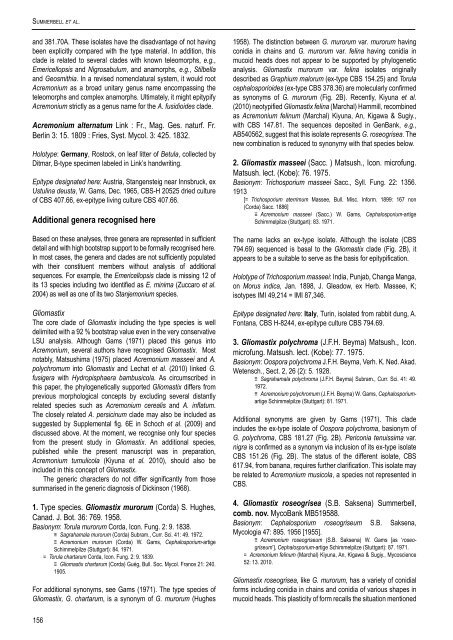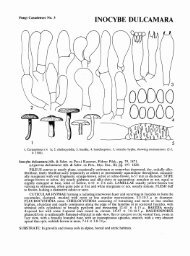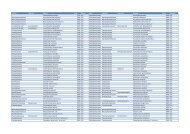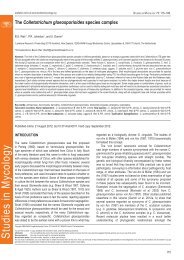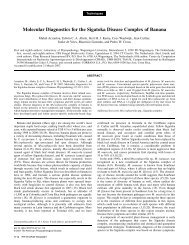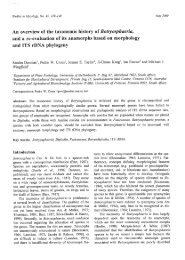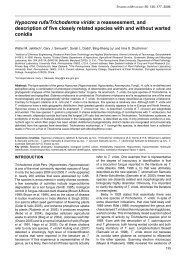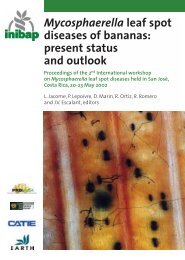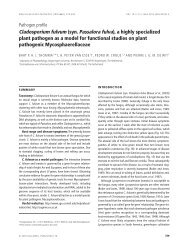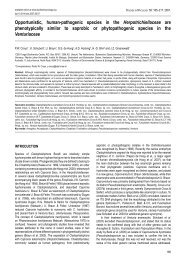Acremonium phylogenetic overview and revision of ... - CBS - KNAW
Acremonium phylogenetic overview and revision of ... - CBS - KNAW
Acremonium phylogenetic overview and revision of ... - CBS - KNAW
Create successful ePaper yourself
Turn your PDF publications into a flip-book with our unique Google optimized e-Paper software.
SuMMerbell et al.<br />
<strong>and</strong> 381.70A. These isolates have the disadvantage <strong>of</strong> not having<br />
been explicitly compared with the type material. In addition, this<br />
clade is related to several clades with known teleomorphs, e.g.,<br />
Emericellopsis <strong>and</strong> Nigrosabulum, <strong>and</strong> anamorphs, e.g., Stilbella<br />
<strong>and</strong> Geosmithia. In a revised nomenclatural system, it would root<br />
<strong>Acremonium</strong> as a broad unitary genus name encompassing the<br />
teleomorphs <strong>and</strong> complex anamorphs. Ultimately, it might epitypify<br />
<strong>Acremonium</strong> strictly as a genus name for the A. fusidioides clade.<br />
<strong>Acremonium</strong> alternatum Link : Fr., Mag. Ges. naturf. Fr.<br />
Berlin 3: 15. 1809 : Fries, Syst. Mycol. 3: 425. 1832.<br />
Holotype: Germany, Rostock, on leaf litter <strong>of</strong> Betula, collected by<br />
Ditmar, B-type specimen labeled in Link’s h<strong>and</strong>writing.<br />
Epitype designated here: Austria, Stangensteig near Innsbruck, ex<br />
Ustulina deusta, W. Gams, Dec. 1965, <strong>CBS</strong>-H 20525 dried culture<br />
<strong>of</strong> <strong>CBS</strong> 407.66, ex-epitype living culture <strong>CBS</strong> 407.66.<br />
Additional genera recognised here<br />
Based on these analyses, three genera are represented in sufficient<br />
detail <strong>and</strong> with high bootstrap support to be formally recognised here.<br />
In most cases, the genera <strong>and</strong> clades are not sufficiently populated<br />
with their constituent members without analysis <strong>of</strong> additional<br />
sequences. For example, the Emericellopsis clade is missing 12 <strong>of</strong><br />
its 13 species including two identified as E. minima (Zuccaro et al.<br />
2004) as well as one <strong>of</strong> its two Stanjemonium species.<br />
Gliomastix<br />
The core clade <strong>of</strong> Gliomastix including the type species is well<br />
delimited with a 92 % bootstrap value even in the very conservative<br />
LSU analysis. Although Gams (1971) placed this genus into<br />
<strong>Acremonium</strong>, several authors have recognised Gliomastix. Most<br />
notably, Matsushima (1975) placed <strong>Acremonium</strong> masseei <strong>and</strong> A.<br />
polychromum into Gliomastix <strong>and</strong> Lechat et al. (2010) linked G.<br />
fusigera with Hydropisphaera bambusicola. As circumscribed in<br />
this paper, the <strong>phylogenetic</strong>ally supported Gliomastix differs from<br />
previous morphological concepts by excluding several distantly<br />
related species such as <strong>Acremonium</strong> cerealis <strong>and</strong> A. inflatum.<br />
The closely related A. persicinum clade may also be included as<br />
suggested by Supplemental fig. 6E in Schoch et al. (2009) <strong>and</strong><br />
discussed above. At the moment, we recognise only four species<br />
from the present study in Gliomastix. An additional species,<br />
published while the present manuscript was in preparation,<br />
<strong>Acremonium</strong> tumulicola (Kiyuna et al. 2010), should also be<br />
included in this concept <strong>of</strong> Gliomastix.<br />
The generic characters do not differ significantly from those<br />
summarised in the generic diagnosis <strong>of</strong> Dickinson (1968).<br />
1. Type species. Gliomastix murorum (Corda) S. Hughes,<br />
Canad. J. Bot. 36: 769. 1958.<br />
Basionym: Torula murorum Corda, Icon. Fung. 2: 9. 1838.<br />
≡ Sagrahamala murorum (Corda) Subram., Curr. Sci. 41: 49. 1972.<br />
≡ <strong>Acremonium</strong> murorum (Corda) W. Gams, Cephalosporium-artige<br />
Schimmelpilze (Stuttgart): 84. 1971.<br />
= Torula chartarum Corda, Icon. Fung. 2: 9. 1839.<br />
≡ Gliomastix chartarum (Corda) Guég, Bull. Soc. Mycol. France 21: 240.<br />
1905.<br />
For additional synonyms, see Gams (1971). The type species <strong>of</strong><br />
Gliomastix, G. chartarum, is a synonym <strong>of</strong> G. murorum (Hughes<br />
156<br />
1958). The distinction between G. murorum var. murorum having<br />
conidia in chains <strong>and</strong> G. murorum var. felina having conidia in<br />
mucoid heads does not appear to be supported by <strong>phylogenetic</strong><br />
analysis. Gliomastix murorum var. felina isolates originally<br />
described as Graphium malorum (ex-type <strong>CBS</strong> 154.25) <strong>and</strong> Torula<br />
cephalosporioides (ex-type <strong>CBS</strong> 378.36) are molecularly confirmed<br />
as synonyms <strong>of</strong> G. murorum (Fig. 2B). Recently, Kiyuna et al.<br />
(2010) neotypified Gliomastix felina (Marchal) Hammill, recombined<br />
as <strong>Acremonium</strong> felinum (Marchal) Kiyuna, An, Kigawa & Sugiy.,<br />
with <strong>CBS</strong> 147.81. The sequences deposited in GenBank, e.g.,<br />
AB540562, suggest that this isolate represents G. roseogrisea. The<br />
new combination is reduced to synonymy with that species below.<br />
2. Gliomastix masseei (Sacc. ) Matsush., Icon. micr<strong>of</strong>ung.<br />
Matsush. lect. (Kobe): 76. 1975.<br />
Basionym: Trichosporium masseei Sacc., Syll. Fung. 22: 1356.<br />
1913 [= Trichosporium aterrimum Massee, Bull. Misc. Inform. 1899: 167 non<br />
(Corda) Sacc. 1886]<br />
≡ <strong>Acremonium</strong> masseei (Sacc.) W. Gams, Cephalosporium-artige<br />
Schimmelpilze (Stuttgart): 83. 1971.<br />
The name lacks an ex-type isolate. Although the isolate (<strong>CBS</strong><br />
794.69) sequenced is basal to the Gliomastix clade (Fig. 2B), it<br />
appears to be a suitable to serve as the basis for epitypification.<br />
Holotype <strong>of</strong> Trichosporium masseei: India, Punjab, Changa Manga,<br />
on Morus indica, Jan. 1898, J. Gleadow, ex Herb. Massee, K;<br />
isotypes IMI 49,214 = IMI 87,346.<br />
Epitype designated here: Italy, Turin, isolated from rabbit dung, A.<br />
Fontana, <strong>CBS</strong> H-8244, ex-epitype culture <strong>CBS</strong> 794.69.<br />
3. Gliomastix polychroma (J.F.H. Beyma) Matsush., Icon.<br />
micr<strong>of</strong>ung. Matsush. lect. (Kobe): 77. 1975.<br />
Basionym: Oospora polychroma J.F.H. Beyma, Verh. K. Ned. Akad.<br />
Wetensch., Sect. 2, 26 (2): 5. 1928.<br />
≡ Sagrahamala polychroma (J.F.H. Beyma) Subram., Curr. Sci. 41: 49.<br />
1972.<br />
≡ <strong>Acremonium</strong> polychromum (J.F.H. Beyma) W. Gams, Cephalosporiumartige<br />
Schimmelpilze (Stuttgart): 81. 1971.<br />
Additional synonyms are given by Gams (1971). This clade<br />
includes the ex-type isolate <strong>of</strong> Oospora polychroma, basionym <strong>of</strong><br />
G. polychroma, <strong>CBS</strong> 181.27 (Fig. 2B). Periconia tenuissima var.<br />
nigra is confirmed as a synonym via inclusion <strong>of</strong> its ex-type isolate<br />
<strong>CBS</strong> 151.26 (Fig. 2B). The status <strong>of</strong> the different isolate, <strong>CBS</strong><br />
617.94, from banana, requires further clarification. This isolate may<br />
be related to <strong>Acremonium</strong> musicola, a species not represented in<br />
<strong>CBS</strong>.<br />
4. Gliomastix roseogrisea (S.B. Saksena) Summerbell,<br />
comb. nov. MycoBank MB519588.<br />
Basionym: Cephalosporium roseogriseum S.B. Saksena,<br />
Mycologia 47: 895. 1956 [1955].<br />
≡ <strong>Acremonium</strong> roseogriseum (S.B. Saksena) W. Gams [as ‘roseogriseum’],<br />
Cephalosporium-artige Schimmelpilze (Stuttgart): 87. 1971.<br />
= <strong>Acremonium</strong> felinum (Marchal) Kiyuna, An, Kigawa & Sugiy., Mycoscience<br />
52: 13. 2010.<br />
Gliomastix roseogrisea, like G. murorum, has a variety <strong>of</strong> conidial<br />
forms including conidia in chains <strong>and</strong> conidia <strong>of</strong> various shapes in<br />
mucoid heads. This plasticity <strong>of</strong> form recalls the situation mentioned


